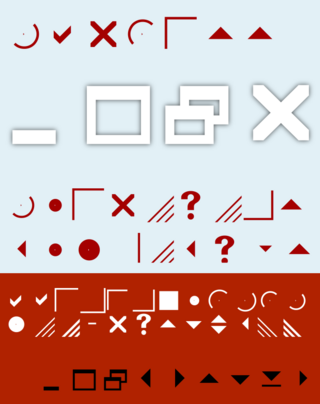Top Qs
Timeline
Chat
Perspective
Marlett
TrueType font used in Microsoft Windows since Windows 95 From Wikipedia, the free encyclopedia
Remove ads
Marlett is a TrueType font that has been used in Microsoft Windows since Windows 95. The operating system uses this font to create user interface icons that are used in the menus and windows.[1] Examples are the close, maximize and minimize buttons that are made from the individual glyphs in the font. This was important to allow the users to scale the user interface and have the icons scale with the elements.[2]
Remove ads
Character layout
Due to the specialised nature of the Marlett glyphs, many of the mappings shown are approximate.
| 0 | 1 | 2 | 3 | 4 | 5 | 6 | 7 | 8 | 9 | A | B | C | D | E | F | |
| 0x | ||||||||||||||||
| 1x | ||||||||||||||||
| 2x | ||||||||||||||||
| 3x | 🗕[a] | 🗖[a] | 🗗[a] | ⏴[a] | ⏵[a] | ⏶[a] | ⏷[a] | ⭳[b] | 🞂 | 🞃 | ||||||
| 4x | ||||||||||||||||
| 5x | ||||||||||||||||
| 6x | ✔[a] | ✓ | 🭽 | 🭿 | ⎾[d] | ⏌[e] | ⬛[a] | • | ● | ◜[f] | ◞[g] | ◜[h] | ◞[i] | ⬤[a] | 🮞 | |
| 7x | 🮞[j] | ─ | 🗙[a] | ❓[a] | ⯅ | ⯆ | ⬍[b] | 🞀 | 🮟 | 🮟[j] |
Remove ads
See also
Footnotes
- Compare this position in Webdings.
- The character 87 (hexa 0x57) represents the Windows icon, which as a corporate logo has no Unicode point. Similar Unicode characters include U+1FA9F 🪟︎ WINDOW. Compare the status of the Apple logo in Mac OS Roman and Mac OS Symbol.
References
External links
Wikiwand - on
Seamless Wikipedia browsing. On steroids.
Remove ads

